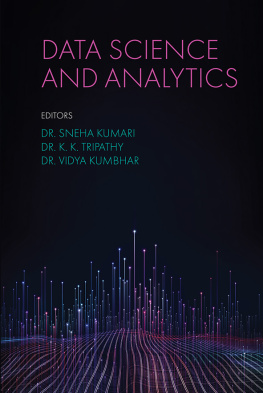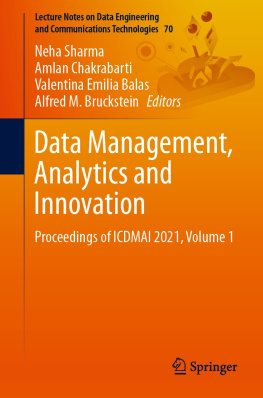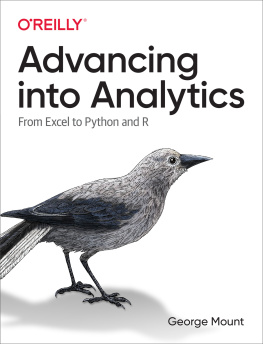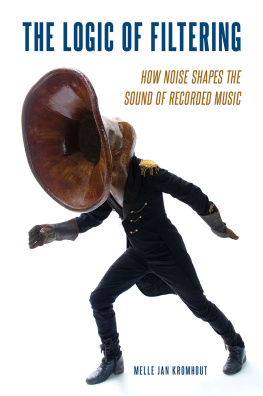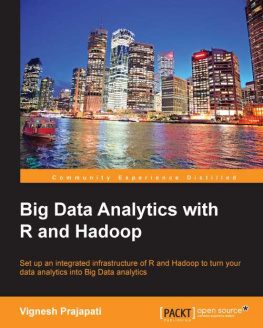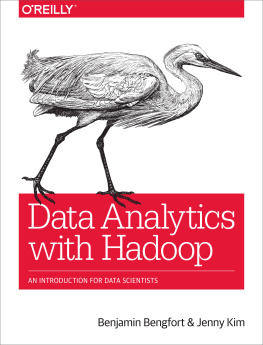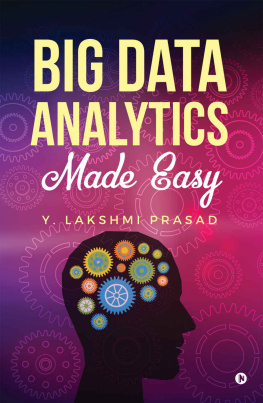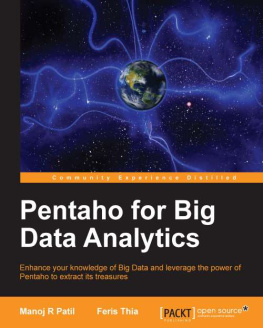Souvik Bhattacharyya - Noise Filtering for Big Data Analytics
Here you can read online Souvik Bhattacharyya - Noise Filtering for Big Data Analytics full text of the book (entire story) in english for free. Download pdf and epub, get meaning, cover and reviews about this ebook. year: 2022, publisher: De Gruyter, genre: Computer. Description of the work, (preface) as well as reviews are available. Best literature library LitArk.com created for fans of good reading and offers a wide selection of genres:
Romance novel
Science fiction
Adventure
Detective
Science
History
Home and family
Prose
Art
Politics
Computer
Non-fiction
Religion
Business
Children
Humor
Choose a favorite category and find really read worthwhile books. Enjoy immersion in the world of imagination, feel the emotions of the characters or learn something new for yourself, make an fascinating discovery.

- Book:Noise Filtering for Big Data Analytics
- Author:
- Publisher:De Gruyter
- Genre:
- Year:2022
- Rating:4 / 5
- Favourites:Add to favourites
- Your mark:
- 80
- 1
- 2
- 3
- 4
- 5
Noise Filtering for Big Data Analytics: summary, description and annotation
We offer to read an annotation, description, summary or preface (depends on what the author of the book "Noise Filtering for Big Data Analytics" wrote himself). If you haven't found the necessary information about the book — write in the comments, we will try to find it.
Noise Filtering for Big Data Analytics — read online for free the complete book (whole text) full work
Below is the text of the book, divided by pages. System saving the place of the last page read, allows you to conveniently read the book "Noise Filtering for Big Data Analytics" online for free, without having to search again every time where you left off. Put a bookmark, and you can go to the page where you finished reading at any time.
Font size:
Interval:
Bookmark:
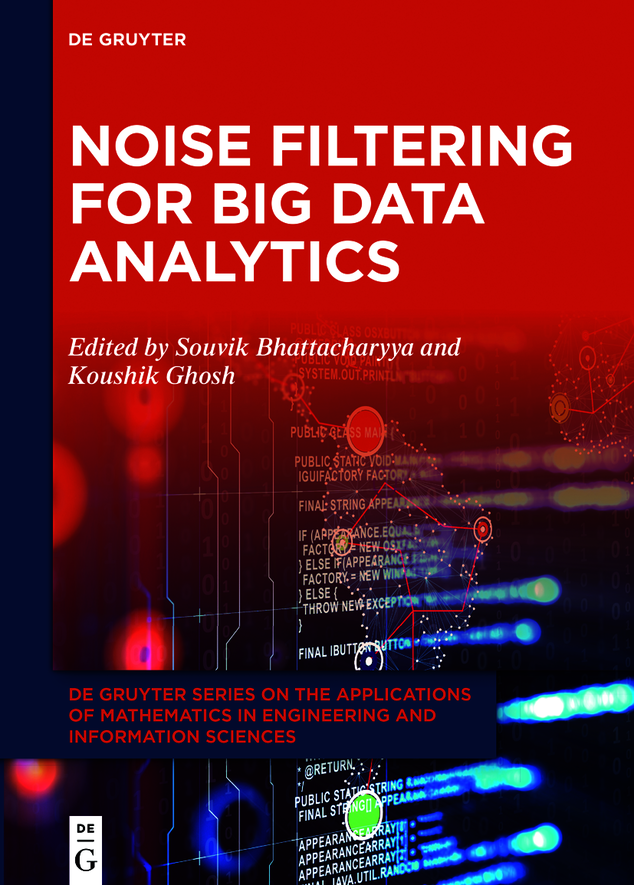
De Gruyter Series on the Applications of Mathematics in Engineering and Information Sciences
Edited by
Volume
ISBN 9783110697094
e-ISBN (PDF) 9783110697216
e-ISBN (EPUB) 9783110697261
Bibliographic information published by the Deutsche Nationalbibliothek
The Deutsche Nationalbibliothek lists this publication in the Deutsche Nationalbibliografie; detailed bibliographic data are available on the Internet at http://dnb.dnb.de.
2022 Walter de Gruyter GmbH, Berlin/Boston
Signal as a noise confined to small scales or high frequency can be removed preferentially from noisy signals if some prior information is available. According to the uncertainty principle, the energy dispersion of a function and its Fourier Transform (FT) cannot be made simultaneously small. Filters in the FT domain applied for signal processing involve a tradeoff between signal-to-noise ratio (SNR) and spatial resolution of the signal processed. Waveforms with a minimal dispersion in a time-frequency surface can be decomposed to retrieve the information about time and frequency. A windowing technique for analyzing non-stationary signals was developed by French geophysicist J. Morlet in the late 1970s to overcome the fixed windowing technique of the short-time Fourier transform (STFT). In lieu of assigning equal width pulses, shorter waveforms at high frequencies are essentially incurred by scaling a single function known as wavelet. An abstraction about conjugated quadrature filters that make a new wavelet transform known as continuous wavelet transform (CWT) was adopted in order to research multiscale image processing in the field of mathematics and computer world. A wavelet transform (WT) can decompose a signal into various spectral components in a time-frequency plane much like STFT, except it has different time-frequency resolution. The digitally implementable counterpart of CWT known as discrete wavelet transform (DWT) provides an octave-band filter bank structure. It is a computationally efficient arrangement of compactly supported orthonormal sequences of a single function localized in both position and scale. Therefore, DWT and its extension packet versionbased noise elimination or suppression exploits the proficiency of WT in denoising largely by providing sparse representations of data. Sparsity entails that most of the smaller value wavelet coefficients will be discarded as noise to yield a noise-free reconstruction and larger value data contains the true signal information. In this wavelet-based shrinkage technique, a noise contaminated signal can be decomposed by operating appropriate orthogonal mother filters of a multiresolution filter bank and soft thresholding is performed to shrink the retained decomposed data. It implies that from each coefficient, a constant value is subtracted. Therefore, this approach has been applied to eliminate noise effectively without affecting the useful information correlated with the high-frequency noise. Also, the coefficients with smaller amplitude than threshold are set to zero but the remaining coefficients are then shrunk to reduce the noise effect presumed to corrupt all the wavelet coefficients. This shrinkage-based signal estimation technique with proper threshold value on the wavelet coefficients would significantly minimize noise.
The selection of proper wavelet and optimal levels of decomposition in signal denoising are important criteria. Denoising performance-based selection of mother filter is time-consuming and cumbersome. Therefore, an alternative algorithm to select optimal wavelet, minimum description length (MDL) method provides the advantages of Bayesian information criteria incorporating the dependence structure within the cluster with penalty function. In this method, initially, model encoding method is applied for data encoding and finally, model is used to encode it. Then the minimized model from the total two-stage description length (DL) of the data should be selected within a few specific model classes. A model data that optimizes the trade-off between model complexity and goodness-of-fit can be selected in this way. The fundamental presumption of this approach is that the cost function reaches a minimum indicating the optimal number of coefficients. The entropy method furnishes a compact mathematical form for calculating the expected uncertainty associated with coefficients decomposed by wavelet transform to select optimal levels.
In this chapter, MDL method is implemented to select optimal mother filter. Shannons entropy is contemplated here to select the proper levels of decomposition in discrete wavelet transform and best basis selection technique for discrete wavelet packet transform. Initially, the formulation of the wavelet-based multiresolution filtering is applied for one-dimensional noisy signal obtained from lab-scale liquid-level plant as well as analogous real-time plant and this algorithm is developed in MATLAB level 2s function. The denoised response is then compared to the conventional filtering technique. It is seen that wavelet filters perform well in terms of improving signal to noise ratio (SNR) and reducing mean squared error (MSE) than traditional technique.
According to the uncertainty principle, simultaneous attainment of minimal value for both Fourier Transform of a function and its energy dispersion is difficult [], for repeat-time-based carrier phase multipath filtering in relative positioning, generic and efficient three-level wavelet packetsbased denoising approach is modeled for GPS data set application. The test results of the WPT denoising are compared with the results of the resistorcapacitor (RC) low pass filter and the single-level DWT-based noise eliminating approach.
The implementation of WT includes the wavelet function and the number of resolution levels to be chosen [].
Rissanens minimum description length (MDL) principle [.
Mathematical transformations are required to extract further information that is not present in the raw signal []. The transform operates by converting a function firstly in time domain to frequency domain and then evaluating its frequency content while the Fourier coefficients provide the information at each frequency about sine and cosine function. An inverse procedure of FT is done to retrieve the time domain signal.
]. The inverse Fourier transform is
y(t) is a continuous signal in time domain. A function that converts a signal into a joint time-frequency domain is necessary for the analysis of the non-stationary signal [] or WFT which can be utilized to furnish data about signals simultaneously in time and frequency domains. It is defined as:
This function can be defined as the FT of signal st , previously windowed by the function gt around time . As the window function is shifted over the whole signal in time and successive overlapping transformations are carried out, an evolution of signal spectrum is accomplished over time. This approach presumes that the signal over the limited window gt is stationary. This chronological arrangement of transform and on a common frequency axis furnishes the signal spectrogram.
Font size:
Interval:
Bookmark:
Similar books «Noise Filtering for Big Data Analytics»
Look at similar books to Noise Filtering for Big Data Analytics. We have selected literature similar in name and meaning in the hope of providing readers with more options to find new, interesting, not yet read works.
Discussion, reviews of the book Noise Filtering for Big Data Analytics and just readers' own opinions. Leave your comments, write what you think about the work, its meaning or the main characters. Specify what exactly you liked and what you didn't like, and why you think so.

